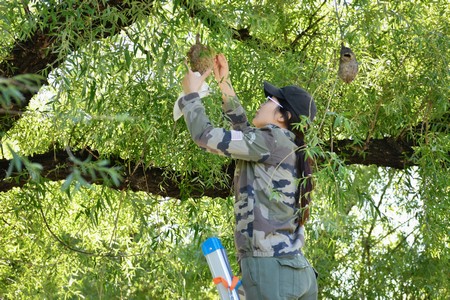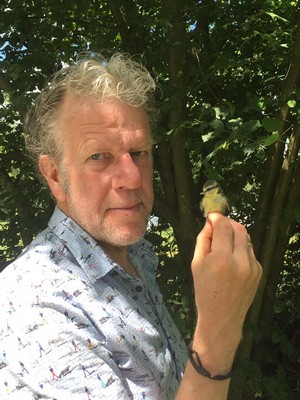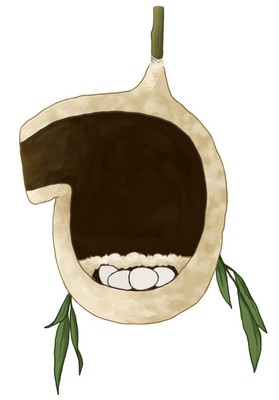Chinese penduline tit buries eggs to prevent them from blowin’ in the wind
Many animal species bury their eggs, for a number of different reasons. While it is firmly established that Eurasian penduline tits bury them because of sexual conflict, their Chinese counterparts seem to have an entirely different reason. Experimental manipulations show that for these birds burial prevents the eggs from falling out of the nest in strong winds. The results of this study by Dutch and Chinese biologists were published in the journal Animal Behaviour on 14 May.
Animals as different as crickets, turtles, or birds bury their eggs, for example to keep them warm or to prevent predation. In the Eurasian penduline tit, sexual conflict is an important reason. Male tits spend about a month building the pouch-shaped nest from thousands of pieces of fluff and feathers. Then, they have to lure in a female that subsequently locks the builder out of his home. ‘In these birds, only the male or only the female will look after the chicks,’ explains Jan Komdeur, Professor of Evolutionary Ecology at the University of Groningen. ‘The other parent sneaks away to try and produce a second clutch.’

Agression
The male birds will not leave until they have seen that the female has started to lay eggs. The female wants the male to stick around until egg laying is finished. This is why she does not let the male in the nest and buries her eggs when she leaves it during the day. In this ‘game of chicken’, one parent is left with the young. ‘And in some cases, both parents leave and the clutch may be lost,’ adds Komdeur. He noted that across all of Europe, penduline tits behave in the same way: only one of the parents will care for the young.
Therefore, it came as a surprise to learn that in Chinese penduline tits, male and female birds share the care and spend the nights together in the nest. ‘I came into contact with Professor Zhengwang Zhang, from Beijing Normal University, and his Chinese Master’s student, Jia Zheng, who noticed that there was no aggression between the sexes in these birds. But they still buried their eggs during the day. The question was why.’
After Zheng had finished her Master’s degree, she went on to do a PhD at the University of Groningen, supervised by Komdeur and Zhang. ‘She wanted to test different hypotheses to explain egg burial in Chinese penduline tits.’ The obvious ones were sexual conflict, defence against egg parasitism, and temperature control. During several breeding seasons, Zheng tested these hypotheses by manipulations of the nesting birds.

Parasitism
‘Sexual conflict seemed unlikely, as there was no aggression between male and female partners. Zheng confirmed this by removing the cover of feathers and other material in which the eggs were buried at the bottom of the nest and observing what would happen,’ says Komdeur. When eggs were buried because of sexual conflict, the female should be the one to rebury the eggs to hide them from the male. Yet, video observations showed that both females and males reburied eggs. ‘Furthermore, the male was allowed in the nest during the night, so he would know when there were eggs in the nest.’
Zheng also ruled out nest parasitism, by depositing an extra egg into the nest during the day, on top of the covering material. ‘These new eggs, either an old penduline tit egg, or a dummy egg, were simply buried by the tits. This showed that they accepted the new eggs as their own eggs, and she concluded that burying is not a measure to prevent parasitism.’
And finally, Zheng tested the temperature hypothesis. Komdeur: ‘This was done by moving half of the eggs to an old nest that was suspended about two meters away from the real nest during egg laying. This was only done during the daytime, when both birds were active in and out of the nest.’ Conditions were the same in both nests but the moved eggs were not buried. ‘By using a fake egg with a temperature sensor, we found that the eggs in the original nest were slightly warmer but this had no effect on the development of the embryos and the hatching success.’

Wind
This left one—slightly more exotic, hypothesis. Chinese penduline tits often build their suspended nests in trees that are situated in windy places, near lakes or at the edge of forests. Zheng remembered an experiment that she executed in 2018 to study temperature regulation. This involved experimental nests in which the eggs were not buried. After checking these nests in the evenings she found that some eggs had fallen from the nest onto the ground. Komdeur: ‘Zheng then hypothesised that egg burial may serve to prevent the wind from blowing eggs out of the nest.’ Therefore, she designed a wind experiment in 2019.
To test this, she placed eggs in several nests and placed an ink cushion in the nest entry holes. Any eggs that would roll near to the nest entry hole would touch it. After one night, she found that 45 percent of the eggs in these experimental nests had ink stains. ‘Looking back, the number of broken eggs during the earlier incident was just about half, statistically the same,’ says Komdeur.
Original function
This led the scientists to conclude that egg burial in the Chinese penduline tit is primarily to prevent the eggs from falling out of the nest. Komdeur: ‘Phylogenetic studies show that Chinese penduline tits are the ancient species in the Remiz genus. Therefore, protecting eggs from rolling out of the nest may be the original function that evolved in all species of the genus.’ The increase in sexual conflict between males and females in the lineage of Eurasian penduline tits may have caused egg burial to fulfil a new function, which is that females use egg burial as a way of deceiving the male partner.
In conclusion, the study has proven beyond reasonable doubt that protection from the wind is the reason why the Chinese tits bury their eggs. ‘Zheng has done wonderful work by testing the different hypotheses in one and the same population during three breeding seasons. And we now know that in related species, such as the Eurasian or Chinese penduline tits, the same behaviour may have a different purpose.’
Reference: Jia Zheng, Emiel Zuidema, Tamás Székely, Mei Guo, Zhengwang Zhang and Jan Komdeur: A novel function of egg burial: burying material prevents eggs rolling out of windswayed nests. Animal Behaviour 14 May
More news
-
02 December 2025
Student Menna Zahran wins Unilever Research Prize
-
27 November 2025
Aeroplane spotting using a radio telescope
-
26 November 2025
Why are shiny colours rare yet widespread in nature?

